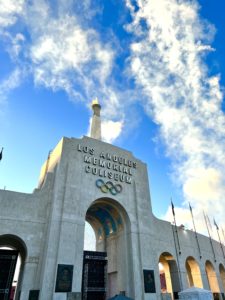
Greetings from Los Angeles, California
From the travels and adventures of the
“World’s #1 Trackchaser”
Los Angeles Memorial Coliseum Paved oval Lifetime Track #2,765 THE EVENT Editor’s note: I’m going to guess that seeing racing at the Los Angeles Memorial Coliseum on a temporary quarter-mile paved oval will be the event highlight of my 2022 trackchasing season. A close second will likely be the Eldora Million race (paying $1 million to win) later this year. I travel this way so you don’t have to. How does that work? I tell you how I travel and then you get to decide if that’s a good idea for you. Welcome to my 2022 trackchasing season! I AM A TRACKCHASER. What’s a trackchaser? What is trackchasing? Trackchasing is a hobby of mine. With trackchasing I do just three things. Each one is of equal importance to me. I travel the world watching auto racing on ovals, road courses and figure 8 tracks. I seek out “Trackchasing Tourist Attractions” during my travels to keep myself entertained when I’m not at the racetrack. I’ve been able to see the world doing this. If you’re interested in exactly what I’ve been able to experience all around the U.S. and the world I recommend you click on this link. Trackchasing Tourist Attractions I plan airline, rental car and hotel accommodations to get me from my home in Southern California to racetracks located in the United States and all over the world. Just the planning part of my hobby is as much fun as anything. I am known as the “World’s #1 Trackchaser”. How did I get that title? I have traveled to 85 different countries and seen racing at nearly 2,800 tracks…that’s how I got that title. If you’re interested in looking back and seeing where I’ve been the following link is for you. If you’ve got a question, comment or whatever please leave it at the bottom of this report. It’s very easy to do. Or you can visit me on Facebook. Thanks! FOREWORD Sunday, February 6, 2022. Who could ever have imagined that in today’s world the NASCAR Cup series would be racing on a temporary quarter-mile asphalt oval on the floor of the Los Angeles Memorial Coliseum? Who could’ve done that? Nobody? However, NASCAR did exactly that. What did I learn from their decision? It’s impossible to predict the future. Last year I went to five different NASCAR Cup races spread across the country. I was always accompanied with my “need one” ticket sign. For the past five years or more I’ve “bought” at two price points for my NASCAR tickets. About half the time when people see my sign, they will actually give me a ticket for free. For the other races, I paid a maximum of $20 to see the race. All of that is well below market value. I just smile when people say ticket prices are too high at a NASCAR race or any event for that matter. Be smart people! My ticket buying strategy would not be in effect for the NASCAR race at the Coliseum. I had invited Carol and our son J.J. and his good friend Dustin. My “need one” sign doesn’t exactly work when you “need four”. I can’t exactly recall what I paid for the tickets but I know it was north of $100 apiece. With Ticketmaster fees, it was probably approaching $150 per seat. I didn’t mind doing that at all. I wanted our outing to be perfect and having good seats is part of “perfect”. With the above being the case we all eagerly anticipated Sunday, February 6, 2022. Like all future dates this one popped up and our day of adventure began. We had heard that parking might be an issue at the Coliseum. Some parts of the area surrounding the Los Angeles Memorial Coliseum are a little sketchy. There isn’t a lot of parking around the Coliseum either. We were thinking that really good parking spots might cost $200 or more. We didn’t want to pay that. J.J. did a little research and soon came up with the idea of parking at one of the city bus lots and grabbing a bus (Metro Silver Line) for the last 10 miles or so of the journey over to the Coliseum. We all downloaded the “Tap” app that city bus riders use. This was much to Carol’s chagrin as she is more than reticent to share her personal information with the man. We put five dollars of usage on our app. The one-way bus ride was a buck and a half. We could ride the buses all day if we liked, which we wouldn’t be doing, for less than the five dollars that we put on our bus “charge card”. People in Southern California are not big “public transportation” people. That being the case it was easy getting on the bus headed toward the coliseum a few hours before the race. It might be, and it was, a little bit more difficult to grab one of the buses when the races were finished. We decided we would deal with that later. We did see parking charges for $100 very near the Coliseum. That was the one and only price sign we saw. It looked as if others might have bought their parking permits in advance of the race at an undisclosed price. I am always amazed and amused at people who complain about inflation. Folks, when something is priced too high find a substitute. The Los Angeles Memorial Coliseum is an iconic venue. It might be the most iconic venue in the U.S. and certainly in the top five. Did you know this about the coliseum? Thanks to Wikipedia I know a lot more about the coliseum after doing my research. The coliseum was completed in 1923, almost 100 years ago as a memorial to the veterans of World War 1. it will become the first stadium to have hosted the Summer Olympics three times when it hosts the 2028 Summer Olympics. The stadium previously hosted the Summer Olympics in 1932 and 1984. We were there to see it all in 1984. It was designated a National Historic Landmark on July 27, 1984, a day before the opening ceremony of the 1984 Summer Olympics. Currently, the dreaded and commonly inept University of Southern California Trojans play their home football games there. The Coliseum was the home of the Los Angeles Rams of the National Football League (NFL) from 1946 to 1979, when they moved to Anaheim Stadium in Anaheim, and again from 2016 to 2019, prior to the team’s move to SoFi Stadium in Inglewood. We owned nine season tickets to the Ram’s games when they played in the coliseum and when they moved to Anaheim Stadium. The facility had a permanent seating capacity of 93,607 for USC football and Rams games, making it the largest football stadium in the Pac-12 Conference and the NFL. The stadium also was the temporary home (above) of the Los Angeles Dodgers of Major League Baseball (MLB) from 1958 to 1961, and was the host venue for games three, four, and 5 of the 1959 World Series. It was the site of the first AFL-NFL World Championship Game (later called Super Bowl I) and Super Bowl VII. Additionally, it has served as a home field for a number of other teams, including the 1960 inaugural season for the Los Angeles Chargers, the Los Angeles Raiders of the NFL, and UCLA Bruins football. From 1959 to 2016, the Los Angeles Memorial Sports Arena was located adjacent to the Coliseum before it closed in March 2016. Banc of California Stadium, a soccer-specific stadium and the home of Major League Soccer (MLS)’s Los Angeles FC, was constructed on the former Sports Arena site, and opened in 2018. In 2018, USC began a major renovation of the stadium, which included replacing the seating along with the addition of luxury boxes and club suites, but lowered the seating capacity to 77,500. The $315 million project was completed by the 2019 football season, and was the first major upgrade of the stadium in twenty years. Notable events 1920s On October 6, 1923, Pomona College and USC played in the inaugural game at the Coliseum, with the Trojans prevailing 23–7. Situated just across the street from Exposition Park, USC agreed to play all its home games at the Coliseum, a circumstance that contributed to the decision to build the arena. From 1928 to 1981, the UCLA Bruins also played home games at the Coliseum (above 1969). When USC and UCLA played each other, the “home” team (USC in odd-numbered years, UCLA in even), occupied the north sideline and bench, and its band and rooters sat on the north side of the stadium; the “visiting” team and its contingent took to the south (press box) side of the stadium. Excepting the mid-1950s and 1983–2007, the two teams have worn their home jerseys for the rivalry games for the Victory Bell. This tradition was renewed in 2008, even though the two schools now play at different stadiums. UCLA moved to the Rose Bowl in Pasadena in 1982. In 1932, the Coliseum hosted the Summer Olympic Games, the first of two Olympic Games hosted at the stadium. The Coliseum served as the site of the field hockey, gymnastics, the show jumping part of the equestrian event, and track and field events, along with the opening and closing ceremonies. The 1932 games marked the introduction of the Olympic Village, as well as the victory podium. The former Cleveland Rams of the National Football League relocated to the Coliseum in 1946, becoming the Los Angeles Rams; however, the team later relocated again, first to Anaheim in 1980, then to St. Louis in 1995, only to move back to Los Angeles in 2016. The Los Angeles Dons of the All-America Football Conference played in the Coliseum from 1946 to 1949, when the franchise merged with its NFL cousins just before the two leagues merged. The Coliseum hosted the NCAA Men’s Division I Outdoor Track and Field Championships in 1934, 1939, 1949, and 1955. It also hosted several Coliseum Relays and several Compton-Coliseum Invitational (track and field) events from the 1940s until the 1970s. Among other sporting events held at the Coliseum over the years were Major League Baseball (MLB) games, which were held when the Brooklyn Dodgers of the National League relocated to the West Coast in 1958. The Dodgers played here until Dodger Stadium was completed in time for the 1962 season. Even allowing for its temporary status, the Coliseum was extremely ill-suited for baseball due to the fundamentally different sizes and shapes of football and baseball fields. A baseball field requires roughly 2.5 times more area than a football gridiron, but the playing surface was just barely large enough to accommodate a baseball diamond. As a result, the foul territory was almost nonexistent down the first baseline, but was expansive down the third baseline, with a very large backstop for the catcher. Sightlines also left much to be desired; some seats were as far as 710 feet (216 m) from the plate. Also, from baseball’s point of view, the locker rooms were huge as they were designed for football (not baseball) teams. In order to shoehorn even an approximation of a baseball field onto the playing surface, the left-field fence was set at only 251 feet (77 m) from the plate. This seemed likely to ensure that there would be many “Chinese home runs”, as such short shots were called at the time. Sportswriters began jokingly referring to the improvised park as “O’Malley’s Chinese Theatre” or “The House that Charlie Chan Built”, drawing protests from the Chinese American community in the Los Angeles area. They also expressed concern that cherished home run records, especially Babe Ruth’s 1927 seasonal mark of 60, might easily fall as a result of 250-foot (76 m) pop flies going over the left-field fence. Sports Illustrated titled a critical editorial “Every Sixth Hit a Homer!” Players also complained, with Milwaukee Braves ace Warren Spahn calling for a rule that would require any home run to travel at least 300 feet (91 m) before it could be considered a home run. Although less than ideal for baseball due to its poor sightlines and short dimensions (left field at 251 feet (77 m) and power alleys at 320 feet (98 m)), the Coliseum was ideally suited for large paying crowds. Each of the three games of the 1959 World Series drew over 92,000 fans, with game five drawing 92,706, a record unlikely to be seriously threatened anytime soon given the smaller seating capacities of today’s baseball parks. In May 1959, an exhibition game between the Dodgers and the New York Yankees in honor of legendary catcher Roy Campanella drew 93,103, the largest crowd ever to see a baseball game in the Western Hemisphere until a 2008 exhibition game between the Los Angeles Dodgers and the Boston Red Sox to mark the 50th anniversary of MLB in Los Angeles. The Coliseum also hosted the second 1959 MLB All-Star Game. The Coliseum was also the site of John F. Kennedy’s memorable acceptance speech (above) at the 1960 Democratic National Convention. It was during that speech that Kennedy first used the term “the New Frontier”. The Rams hosted the 1949, 1951 and 1955 NFL championship games at the Coliseum. The Coliseum was also the site of the very first NFL-AFL Championship Game in 1967 (above), an event since renamed the Super Bowl. It also hosted Super Bowl VII in 1973, but future Super Bowls in the Los Angeles region would instead be hosted at the Rose Bowl, which has never had an NFL tenant. The Coliseum was also the site of the NFL Pro Bowl from 1951 to 1972, and again in 1979. In 1960, the American Football League (AFL)’s Los Angeles Chargers played at the Coliseum before relocating to San Diego the next year; the team moved back to the L.A. area in 2017. The United States men’s national soccer team played its first match at the stadium in 1965, losing to Mexico in a 1966 World Cup qualifier. Also, the Los Angeles Wolves of the United Soccer Association played their home games at the Coliseum for a year (1967) before moving to the Rose Bowl. In July 1972, the Coliseum hosted the “Super Bowl” of Motocross (above). The event was the first motocross race held inside a stadium. It evolved into the AMA Supercross championship held in stadiums across the United States and Canada. The Coliseum last hosted the event in 1998. On August 20, 1972, Wattstax, also known as “Black-Woodstock”, took place in the Coliseum. Over 100,000 black residents of Los Angeles attended this concert for African-American pride. Later in 1973, a documentary was released about the concert. In 1973, Evel Knievel used the entire distance of the stadium to jump 50 stacked cars. Knievel launched his motorcycle from atop one end of the Coliseum, jumping the cars in the center of the field, and stopping high atop the other end. The jump was broadcast on ABC’s Wide World of Sports.[58] Also in 1973, the Coliseum was host to Super Bowl VII, which saw the AFC champion Miami Dolphins defeat the NFC champion Washington Redskins 14–7, becoming the only team in NFL history to attain an undefeated season and postseason. The Mickey Thompson Entertainment Group hosted the first stadium short course off-road race at the Coliseum in 1979. The event was last held in 1992. The Los Angeles Aztecs of the North American Soccer League used the Coliseum as their home ground in 1977 and 1981. The Coliseum was also home to the USFL’s Los Angeles Express between 1983 and 1985. In this capacity, the stadium also is the site of the longest professional American football game in history: on June 30, 1984 (a few weeks before the start of the 1984 Summer Olympics), a triple-overtime game between the Express and the Michigan Panthers that was decided on a 24-yard game-winning touchdown by Mel Gray of the Express, three and a half minutes into the third overtime, to give Los Angeles a 27–21 win. Until 2012, this game marked the only time in the history of professional football that there was more than one kickoff in overtime play in the same game. In 1982, the former Oakland Raiders moved in. The same year, UCLA decided to move out, relocating its home games to the Rose Bowl in Pasadena. The Coliseum was also the site of the 1982 Speedway World Final, held for the first and only time in the United States. The event saw Newport Beach native Bruce Penhall retain the title he had won in front of 92,500 fans at London’s Wembley Stadium in 1981. An estimated 40,000 fans were at the Coliseum to see Penhall retain his title before announcing his retirement from motorcycle speedway to take up an acting role on the television series CHiPs. Carol and I were there for this one! Los Angeles hosted the 1984 Summer Olympics, and the Coliseum became the first stadium to host the Summer Olympic Games twice; again serving as the primary track and field venue and as the site of the opening and closing ceremonies. The Rolling Stones played at the stadium on their 1981 Tattoo You tour (October 9 and 11), supported by George Thorogood, the J. Geils Band, and relatively unknown newcomer Prince. Bruce Springsteen and the E Street Band concluded their Born in the U.S.A. Tour with four consecutive concerts on September 27, 29, 30, and October 2, 1985. U2 played at the stadium during leg three of their breakout Joshua Tree tour on November 17 and 18, 1987. Los Angeles natives Mötley Crüe played at the stadium on December 13, 1987, during the second leg of their Girls, Girls, Girls World Tour, with fellow Los Angeles band Guns N’ Roses as the opening act. At that time, Mötley Crüe was one of the most popular and successful acts in the world, while Guns N’ Roses was one of the largest up-and-coming acts. The latter would later return for four shows in October 1989 as the opening act for the Rolling Stones, then again on September 27, 1992 as part of their infamous co-headlining tour with Metallica. The Raiders began looking to move out of the Coliseum as early as 1986. In addition to the delays in renovating the stadium, they never drew well; even after they won Super Bowl XVIII in 1984, they had trouble filling it. Finally, in 1995, the Raiders left Los Angeles and returned to Oakland, leaving the Coliseum without a professional football tenant for the first time since the close of World War II. In May 1959, the Dodgers had hosted an exhibition game against the reigning World Series champion New York Yankees at the Coliseum, a game which drew over 93,000 people. The Yankees won that game 6–2. As part of their West Coast 50th anniversary celebration in 2008, the Dodgers again hosted an exhibition game against the reigning World Series champions, the Boston Red Sox. On March 29, 2008, the middle game of a three-game set in Los Angeles was also won by the visitors by the relatively low score of 7–4, given the layout of the field; Red Sox catcher Jason Varitek had joked that he expected scores in the 80s. On June 23, 2008, the Los Angeles Memorial Coliseum Commission announced that they were putting the naming rights of the Coliseum on the market, predicting a deal valued at $6 million to $8 million a year. The funds would go towards financing over $100 million in renovations over the next decade, including a new video board, bathrooms, concession areas, and locker rooms. Additional seating was included in the renovation plans which increased the Coliseum’s seating capacity to 93,607 in September 2008. On June 17, 2009, the Coliseum was the terminus for the Los Angeles Lakers’ 2009 NBA championship victory parade. A crowd of over 90,000 attended the festivities, in addition to the throngs of supporters who lined the 2-mile (3.2 km) parade route. The Coliseum peristyle was redesigned in purple and gold regalia to commemorate the team, and the Lakers’ court was transported from Staples Center to the Coliseum field to act as the stage. On July 30, 2011, the LA Rising festival with Rage Against the Machine, Muse, Rise Against, Lauryn Hill, Immortal Technique, and El Gran Silencio was hosted at the Coliseum. On April 27, 2013, the stadium hosted a round of the Stadium Super Trucks off-road race. Carol and I were there for this one! On September 13, 2014, the Coliseum hosted the fifth-place game, third-place game and final of the 2014 Copa Centroamericana in front of 41,969 spectators. In August 2015, the Coliseum hosted the opening and closing ceremonies for the 2015 Special Olympics World Summer Games. On September 14, 2021, the NASCAR Cup Series announced that the annual Busch Clash would take place at the Coliseum, at a purpose-made quarter-mile track. On December 9, 2021, Kanye West performed a benefit concert for the long-imprisoned Larry Hoover with special guest Drake at the Coliseum. On January 12, 2016, the NFL gave permission for the St. Louis Rams to relocate back to Los Angeles. The Rams resumed play at the Coliseum while awaiting completion of SoFi Stadium in Inglewood. On August 13, 2016, the Coliseum hosted its first NFL game at the stadium since 1994, as the Rams hosted Dallas Cowboys at a preseason game to a crowd of 89,140 people. On September 18, 2016, the Coliseum hosted the first Rams regular season home game since 1979, against the Seattle Seahawks. On November 19, 2018, the Coliseum hosted its first Monday Night Football game since 1985, and the first Monday night game the Rams hosted at the Coliseum, exact date 40 years later, with the Rams taking on the Kansas City Chiefs. That game, which was originally scheduled to be played at Estadio Azteca in Mexico City that night, was moved to the Coliseum due to poor field conditions at the former. The Rams won the game, 54–51 in the highest-scoring game in Monday Night Football history. Los Angeles will host the Summer Olympics in 2028. During the 131st IOC Session, the International Olympic Committee officially awarded the 2028 Summer Olympics to Los Angeles on July 31, 2017. The Coliseum will be the first stadium to host events for three different Olympic games. The largest gathering in the Coliseum’s history (above) was a Billy Graham crusade which took place on September 8, 1963, with 134,254 in attendance, noted by the Coliseum’s website as an all-time record. With the renovations of 1964, the capacity of the Coliseum was reduced to roughly 93,000 for future events. “Commemorating outstanding persons or events, athletic or otherwise, that have had a definite impact upon the history, glory, and growth of the Los Angeles Memorial Coliseum”[99] Olympic Cauldron The Olympic cauldron was built for the 1932 Summer Olympics and was also reused during the 1984 Summer Olympics. The cauldron is a main sight on stadium and is still present in the Stadium and is lit during special events (such as the period when an edition of the Olympic Games is being held in another city or in mourning for some personality related to the city). As the stadium was the main venue on the 2015 Special Olympics World Summer Games the cauldron was relit by Rafer Johnson during the opening ceremonies and being extinguished again during the closing ceremony. In addition, the torch has been lit on the following historic occasions: So NOW do you think of the Los Angeles Memorial Coliseum as the most iconic sports venue in the United States? I do. When we arrived, we needed to wear a mask and show our vaccine status. The vaccine status was not closely monitored. Once inside we joined probably 80-90% of the crowd in not wearing masks. I must say I do get a kick out of people who lose their shit when they hear masks are required for this or that during the Covid pandemic. In reality enforcement of these policies normally, except in airports and on airplanes, is rarely enforced. Come on, folks. Don’t lose your lunch over something that in most cases doesn’t exist. Try to live in reality. The next thing I wanted to do was to pick up our race scanners and noise-canceling headsets at the Racing Electronics trailer. I had reserved a pair of those for J.J. and Dustin. They were both attending their first-ever NASCAR race. I would recommend to anyone, new fan or not, that they have a noise-canceling headset and race scanner. The headset keeps you from going deaf. The race scanner allows you to keep up with the radio broadcast of the race and also listen to the crew-to-driver conversations. I wouldn’t have any interest in going to a NASCAR race without either one of these aids. Initially, the line to get the race scanners looked to be many times longer than at any race I’ve ever seen for NASCAR in the past. It was just lucky for us that the line wound around the “VIP” entrance. By the way the line was much longer than what I have pictured. In the short time we were in the Scanner line Sheamus the WWE wrestler came by. He was gracious enough to take a photo with Carol. Then Kaitlyn Jenner, formerly Bruce Jenner, walked in with her friends. Not too many people remember that Jenner drove sports cars in celebrity events and did very well. Carol and I attended a small town side-by-side/ATV event where Kaitlyn Jenner was also in attendance about a year ago or so. She was following some of her relatives who were competing. Jenner was very knowledgeable about racing in general. I was impressed by that. I had prepared a customized race program for everyone in our group. It was sorted by car number. The program included the driver’s name, hometown and the make of racer they would be driving. I also added some comments that you wouldn’t see in any official race program. Here’s a reduced version of the program for you to see. Some people were predicting various levels of carnage due to the shortness and narrowness of the race track. None of these predictions came into play. The race program on this day looked like this. The 36 NASCAR charter teams all had entries. Based upon yesterday’s time trials the four heat races would feature nine cars each. The top four finishers in the 25 lap heat races would automatically transfer to the main event. Then the lowest five finishing drivers in the heat races would move on to two last chance qualifiers. The LCF’s would be 50 laps in distance with the top three in each race transferring to the main. The 23rd and final qualifier would be the highest point finisher from last year who had not already been qualified for today’s main event. That turned out to be Martin Truex Jr. (above). The feature race would be 150 laps on the quarter-mile paved oval, a racing distance of 37.5 miles. That’s a pretty short distance when you consider that NASCAR’s longest race is the Coke 600, which carries a race distance of 600 miles. The very next race for NASCAR will be the Daytona 500. In terms of distance, the 500 will be about 15 times longer than what we would see today. The weather was drop-dead Southern California gorgeous. Recall this race was taking place on February 6. The high temperature was expected to be 78° under 100% sunny skies and it was. I believe the event would have been perceived much differently if it were done in temperatures of 50° with any kind of precipitation. We had seats in row 31 about midway between the fourth turn and the start/finish line. The coliseum seats about 78,000 people. My guesstimate on the crowd today was somewhere around 60,000. There really isn’t a bad seat in the entire place for auto racing. There were a lot of food and drink concession areas offering something for just about anyone’s taste. We started off with hotdogs and pretzels with pretty much a zero weight time. Later Dustin, a native of North Dakota and therefore a nearby resident of Canada, went off to secure some poutine for us which was absolutely delicious. The noise from the race cars was loud but not nearly as loud as most NASCAR races that I’ve been to. Remember the heat races and last chance qualifiers had a maximum of 10 entries. A normal NASCAR race that goes on for three or four hours starts with 40 cars and a lot more noise. I wore my Dale Earnhardt Junior T-shirt. I didn’t see anyone else wearing any Dale Jr. garb. How quickly they forget, right? Overall, I thought the racing was good. I really liked the “choose rule”. On restarts this allowed each car to choose whether they wanted to begin the restart on the inside lane or outside lane. Today the inside lane was much preferred. However, sometimes a driver who might be running in eighth place could move up to row one or two on the restart if they chose the outside lane while everyone else chose the inside line. When the heat and last chance qualifiers were finished the next item on the program was a concert by the singer Pitbull. I will admit it. I had to Google “Pitbull” to figure out what he was all about! Pitbull is a popular Cuban Latin singer. Then during the feature race, they had a break at 75 laps the midway point for today’s event. The rapper “Ice Cube” performed for six minutes to the delight of most people in the crowd. With the exception of possibly driver Mark Martin, I don’t think most long-time NASCAR fans are that much into rap music. If I had to generalize, I would say that most older NASCAR fans like two forms of music. The first will be country and the second would be Western. Dave Moody thanks for that line! I am old enough to be an “old-timer”. Lots of old-timers I know think they are spreading wisdom when in reality they are sharing with the general public their inability to accept change and adapt to new ideas. I never want to be THAT old-time timer. Times change. Technology is a big part of the change that we encounter. I don’t think someone who says they are “old school” sounds all that brilliant to me. To me, they sound like they are unwilling to accept new ideas and are stuck in the past. But then that’s just me. As always, I would hardily recommend you look at my photo album and video from today’s event. That’s right. It was an event and not just a race. I think the future of NASCAR is going to include a lot more “event” to go with their racing than they ever have in the past. The day after the racing I listened in on the NASCAR channel on SiriusXM radio. Almost everyone was giving glowing reports of the event at the Los Angeles Memorial Coliseum. There were a few challenges. Some folks didn’t like the musical artists that were employed for the race. On the contrary, I liked it a lot. I would likely never go to a Pitbull or Ice Cube concert but to see them for “free” at a NASCAR race was a plus. I liked that idea very much. Some people complained of the crowd was small in seemingly an effort to try to tell the general public that no one cares for NASCAR anymore. For gosh sakes the Coliseum seat 78,000. It was probably 80 to 85% full today at ticket prices ranging from $65 to well over $100. That’s a big crowd to me. In all likelihood, NASCAR’s attendance for the race was probably the biggest sporting crowd of the weekend anywhere in the world. Plus I have a minor complaint about the selection of both Pitbull and Ice Cube but it has nothing to do with their music genre. They performed at one into the stadium in the eastern portion of the coliseum beyond turns one and two. That was a “long way” from where most of the fans were seated. I know that it looked good on TV but I would have preferred they perform in the center of the pit area or maybe on a flatbed truck that slowly circled the track. We did run into one potentially life-threatening incident at the conclusion of the race today. We walked a few blocks over to where we could catch the bus back to where our car was parked. Despite nearly 60,000 people flying out of the coliseum at roughly the same time, there were probably only 100 people are so waiting to catch one of the buses that we needed. These 100 people were crammed into a very small space all waiting for the next bus to come along at what was basically a single lane entry point. One fellow was getting just a little bit anxious. I think he was involved in a little bit of horse play as well. Maybe the track’s liquid refreshments had made him especially stupid. When the bus entered this narrow entry way it was really critical to those wanting to board the bus as to where the bus exactly stopped. This idiot was leaning over from where all of the riders were waiting for the bus and trying to influence the driver to stop the bus so the doors would open right in front of this guy. He probably leaned over the safe space by about 2 feet while trying to encourage the driver to meet his request. It was dark. I think the guy missed one critical point. He could see the bus but he didn’t see the mirror extending out a foot and a half from the front of the bus. In comes the bus at about 20 miles an hour like a NASCAR racer gliding into his pitstop. At that speed, the outside mirror on the bus or potentially even the front corner of the bus struck our jokester. Whatever it was it hit this guy right in the head and he fell to the ground like he was shot by a sniper. With all of this was happening the bus went another 20 feet forward and opened the doors. My group pushed and shoved to get onto the bus. The bus probably had a capacity of 40 people and there were now 75 on it. We had to stand. However, the bus didn’t take off as we had hoped. There were now going to be medical personnel summoned and reports to be filed. The bus didn’t move. We had to stand there for a good 30 or 40 minutes. That was uncomfortable and a potential Covid spreader! I think the guy was OK but don’t know for certain. The impact of the bus on this character was within 25 feet of where we were standing in a mob of people. It was an accident that could have easily been fatal. From there Carol, J.J. Dustin and I rounded up our cars and headed for dinner at a kebab restaurant. We all agreed it had been a full day and a fun day. That’s what I had hoped for when this project came on my radar screen and that’s what we got. Will NASCAR come back to the Los Angeles Memorial Coliseum next year? I don’t know. I do know this. Sometimes the “novelty” wears off of a very much anticipated event the next time it is held. I was at the inaugural race at the Las Vegas Motor Speedway in 1996. The seating capacity at LVMS is 80,000 fans. They were racing Indy cars. The crowd at the track was so strong that even one more body could have been able to go through the turn styles. What happened the next year? They had a crowd of about 10,000 people in a place that seats eight times that! I fear that is a possibility with having a race at the Los Angeles Memorial Coliseum again next year. I might be wrong. I know that NASCAR would like to try this at other venues but if they do it for the Busch Clash in February climate is going to influence things a good deal. We’ll just have to wait and see but I think NASCAR is onto something with making the event a racing/concert vibe compared to simply having 500 miles of nonstop engine noise. We’ll see. Remember, we can’t predict the future as our horseplay artist has come to find out. Randy Lewis – 85 countries – 2,765 tracks. California The Golden State This afternoon I saw racing at my 179th-lifetime track in the Golden, yes, the Golden State. I hold the #1 trackchasing ranking in California. California ranks #1, amongst all the states, in tracks seen for me in the U.S. Here’s a link to my all-time California state trackchasing list. I have made 148 separate trips to California to see these tracks. Thanks for reading about my trackchasing, Randy Lewis World’s #1 Trackchaser Peoria Old Timers Racing Club (P.O.R.C.) Hall of Fame Member Californians are deeply proud of their In-N-Out, a fast-food burger chain that comes with its own jargon and a secret menu not advertised in stores. A burger served “animal style” has mustard fried into the patty and comes with extra spread and grilled onions. You can also order your fries animal style. If you’re especially hungry, try a 3×3 burger, which comes with three beef patties, or even a 4×4, which comes with four. JUST THE FACTS LIFETIME TRACKCHASER COMPARISONS The three most important trackchasing comparisons to me are: Total lifetime tracks seen Total “trackchasing countries” seen Lifetime National Geographic Diversity results Total Lifetime Tracks There are no trackchasers currently within 865 tracks of my lifetime total. That’s a fact, Jack. Total Trackchasing Countries My nearest trackchasing competitor, a native of Belgium, has seen racing in more than 30 fewer countries compared to my lifetime total. Current lifetime National Geographic Diversity results That’s all folks! Official end of the RLR – Randy Lewis Racing Trackchaser Report Click on the link below to see the video production from the racing action today. See it in pictures! Click on the link below for a photo album from today’s trackchasing day. You can view the album slide by slide or click on the “slide show” icon for a self-guided tour of today’s trackchasing adventure. Each trip includes a lot of photos of the “trip” and not just the racing. From one U.S. senator, “I think if I wanted to see what this adventure was like and didn’t have all that much time, I would just look at the photo album.” All photo albums are fully captioned. Built it and they will come…and they did to the iconic Los Angeles Memorial Coliseum 

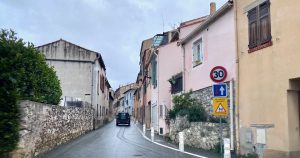












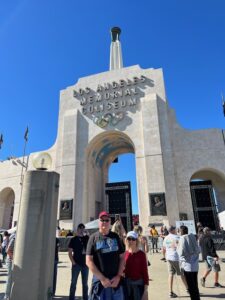




1930s–1940s

1950s–1960s[edit]


1970s–1980s



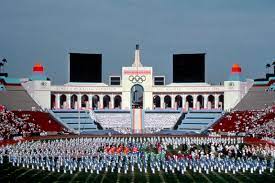
1990s–2000s

2010s–present
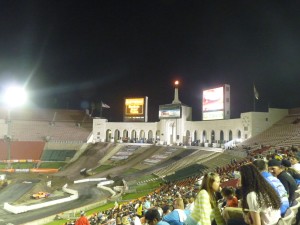

2028 Summer Olympics
Attendance records
1963 Billy Graham Crusade

“Court of Honor” plaques






Car #
Driver
Comment
1
Ross Chastain
Watermelon farmer
2
Austin Cindric
Son of Penske Racing president
3
Austin Dillon
Played 2nd base in little league world series
4
Kevin Harvick*
Won 58 NASCAR races; older driver
5
Kyle Larson*
16 wins; 2021 NASCAR champion; considered the best driver
6
Brad Keselowski*
Smart guy; part-owner of his race team
7
Corey Lajoie
Young guy; inexperienced
8
Tyler Reddick
Up and coming young driver
9
Chase Elliott*
13 wins; 2020 NASCAR champion; flies his own plane to races
10
Aric Almirola
Cuban descent; will retire after this year
11
Denny Hamlin*
46 wins; Probably best driver never to win a championship
12
Ryan Blaney*
Up and coming James Dean lookalike
14
Chase Briscoe
Young driver; mediocre
15
Ryan Preece
Young driver; mediocre
16
AJ Allmendinger
Smart; wise guy; decent driver
17
Chris Buescher
Quiet Texan; middle of the pack
18
Kyle Busch*
Won 59 NASCAR races; the bad boy of NASCAR
19
Martin Truex Jr*
31 wins; Past champion; all-around nice guy
20
Christopher Bell*
Young driver; great on the dirt tracks
21
Harrison Burton
Rookie; just getting started
22
Joey Logano*
27 wins; Past champion; one of my favorites; well-spoken
23
Bubba Wallace
Only black driver; Team owned by Michael Jordan
24
William Byron*
Young driver coming on strong
31
Justin Haley
Young driver; weak team
34
Michael McDowell
Won Daytona 500 last year; weak team
38
Todd Gilliland
Family from Anaheim; weak team
41
Cole Custer
Young driver; won one race
42
Ty Dillon
Middle of the pack driver
43
Erik Jones
Good driver; weak team
45
Kurt Busch*
33 wins; Oldest driver in the field; competitive
47
Ricky Stenhouse Jr
Wildest driver in the field
48
Alex Bowman*
Solid; won 4 times last year
51
Cody Ware
Rookie; just getting started
77
Landon Cassill
Veteran; always with weak teams
78
BJ McLeod
Wear team; no chance
99
Daniel Suarez
Only Mexican driver in the field; decent
* Driver to watch




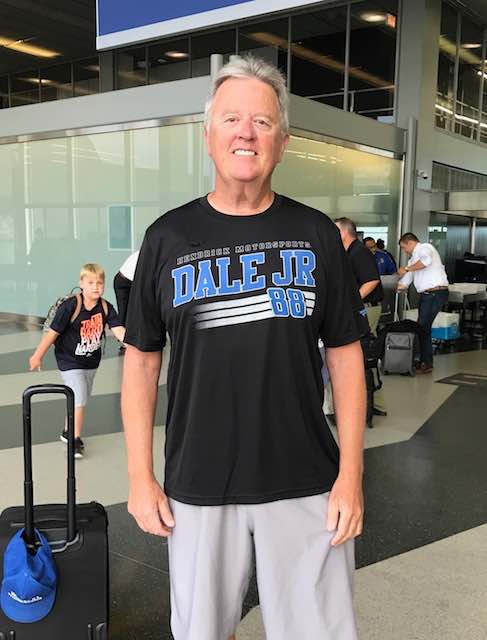







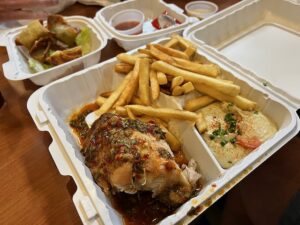


California sayings: “I’ll take a Double-Double, animal style.”




